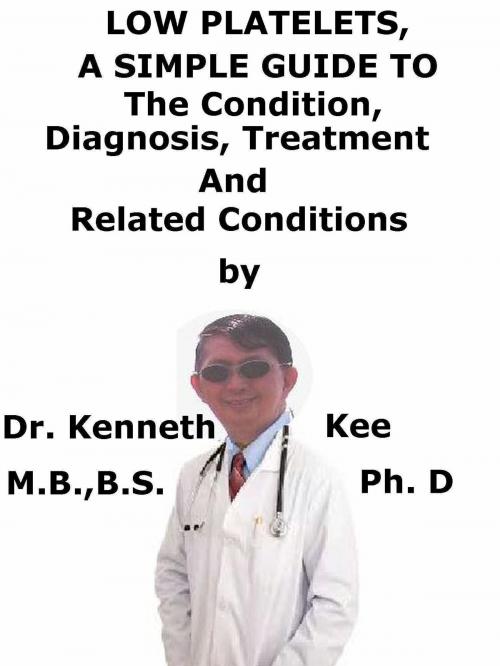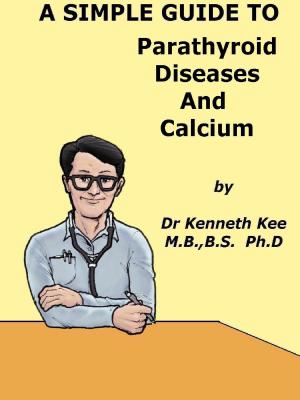Low Platelets, A Simple Guide To The Condition, Diagnosis, Treatment And Related Conditions
Nonfiction, Health & Well Being, Medical, Specialties, Internal Medicine, Hematology| Author: | Kenneth Kee | ISBN: | 9781370370023 |
| Publisher: | Kenneth Kee | Publication: | October 12, 2016 |
| Imprint: | Smashwords Edition | Language: | English |
| Author: | Kenneth Kee |
| ISBN: | 9781370370023 |
| Publisher: | Kenneth Kee |
| Publication: | October 12, 2016 |
| Imprint: | Smashwords Edition |
| Language: | English |
Low Platelets (Thrombocytopenia) is a medical disorder in which the blood has a fewer than normal number of blood cell fragments called platelets.
Platelets are produced in the bone marrow together with other kinds of blood cells.
They stick together (clot) to seal small cuts or breaks on blood vessel walls and stop bleeding that may happen if a blood vessel is damaged.
Because a clot also is known as a thrombus, platelets also are called thrombocytes.
The normal platelet count in adults varies from 150,000 to 450,000 platelets per micro-liter of blood.
A blood cell count of less than 150,000 platelets per micro-liter is fewer than normal.
If the blood platelet count drops lower than normal, you have thrombocytopenia.
When the blood has too little platelets, mild to severe bleeding can happen.
If there is not sufficient platelets, bleeding can happen inside the body (internal bleeding) or underneath or from the skin (external bleeding).
Purpura is caused by bleeding from small blood vessels under the skin.
People who have low platelets may have bleeding that produces tiny red or purple dots on the skin.
These tiny pin-sized red dots are known as petechiae.
The causes of a low platelet count are:
1. The body's bone marrow does not produce sufficient platelets.
2. The bone marrow produces sufficient platelets but the body antibodies damages and destroys the platelets or makes use of the platelets.
3. The spleen contains too many platelets in its organ tissues.
Mild thrombocytopenia frequently may not need treatment.
If the disorder produces or place it in danger of severe bleeding, medicines or blood or platelet transfusions may prevent bleeding.
Less frequently, the spleen in patients may require surgical excision.
The overall outcome for people who have the disorder is good, particularly if the cause of the low platelet count is detected and treated.
Today I have a patient who was found to have low platelets (34,000 per micro-liter blood) as compared to normal (150,000 to 400,000) on a pre-employment medical examination.
He said that he bruises easily after an injury.
He had no fever or infection such as dengue fever which can lower blood counts.
He has no enlarged spleen or liver which may suggest Immune Thrombocytopenia Purpura,
However his brother also has low platelets which suggest hereditary thrombocytopenia or low platelets.
I reassured him and suggested avoiding skin or body injuries which in the case of low platelets may cause excess bleeding.
TABLE OF CONTENT
Introduction
Chapter 1 Low Platelets
Chapter 2 Causes
Chapter 3 Symptoms
Chapter 4 Diagnosis
Chapter 5 Treatment
Chapter 6 Prognosis
Chapter 7 Petechiae
Chapter 8 Purpura
Chapter 9 Idiopathic Thrombocytopenia Purpura
Epilogue
Low Platelets (Thrombocytopenia) is a medical disorder in which the blood has a fewer than normal number of blood cell fragments called platelets.
Platelets are produced in the bone marrow together with other kinds of blood cells.
They stick together (clot) to seal small cuts or breaks on blood vessel walls and stop bleeding that may happen if a blood vessel is damaged.
Because a clot also is known as a thrombus, platelets also are called thrombocytes.
The normal platelet count in adults varies from 150,000 to 450,000 platelets per micro-liter of blood.
A blood cell count of less than 150,000 platelets per micro-liter is fewer than normal.
If the blood platelet count drops lower than normal, you have thrombocytopenia.
When the blood has too little platelets, mild to severe bleeding can happen.
If there is not sufficient platelets, bleeding can happen inside the body (internal bleeding) or underneath or from the skin (external bleeding).
Purpura is caused by bleeding from small blood vessels under the skin.
People who have low platelets may have bleeding that produces tiny red or purple dots on the skin.
These tiny pin-sized red dots are known as petechiae.
The causes of a low platelet count are:
1. The body's bone marrow does not produce sufficient platelets.
2. The bone marrow produces sufficient platelets but the body antibodies damages and destroys the platelets or makes use of the platelets.
3. The spleen contains too many platelets in its organ tissues.
Mild thrombocytopenia frequently may not need treatment.
If the disorder produces or place it in danger of severe bleeding, medicines or blood or platelet transfusions may prevent bleeding.
Less frequently, the spleen in patients may require surgical excision.
The overall outcome for people who have the disorder is good, particularly if the cause of the low platelet count is detected and treated.
Today I have a patient who was found to have low platelets (34,000 per micro-liter blood) as compared to normal (150,000 to 400,000) on a pre-employment medical examination.
He said that he bruises easily after an injury.
He had no fever or infection such as dengue fever which can lower blood counts.
He has no enlarged spleen or liver which may suggest Immune Thrombocytopenia Purpura,
However his brother also has low platelets which suggest hereditary thrombocytopenia or low platelets.
I reassured him and suggested avoiding skin or body injuries which in the case of low platelets may cause excess bleeding.
TABLE OF CONTENT
Introduction
Chapter 1 Low Platelets
Chapter 2 Causes
Chapter 3 Symptoms
Chapter 4 Diagnosis
Chapter 5 Treatment
Chapter 6 Prognosis
Chapter 7 Petechiae
Chapter 8 Purpura
Chapter 9 Idiopathic Thrombocytopenia Purpura
Epilogue















